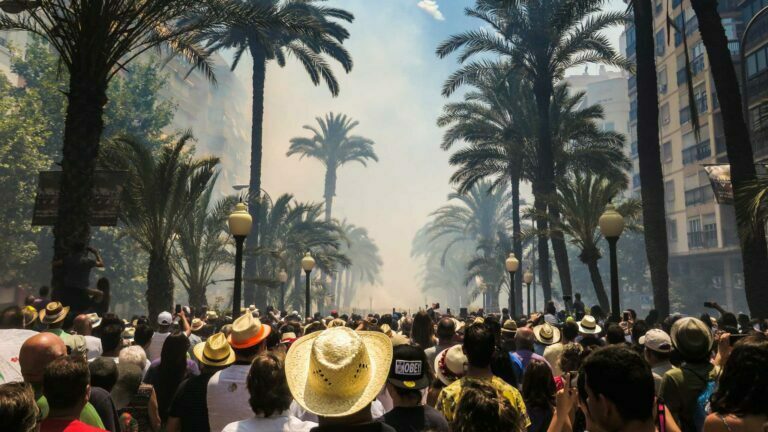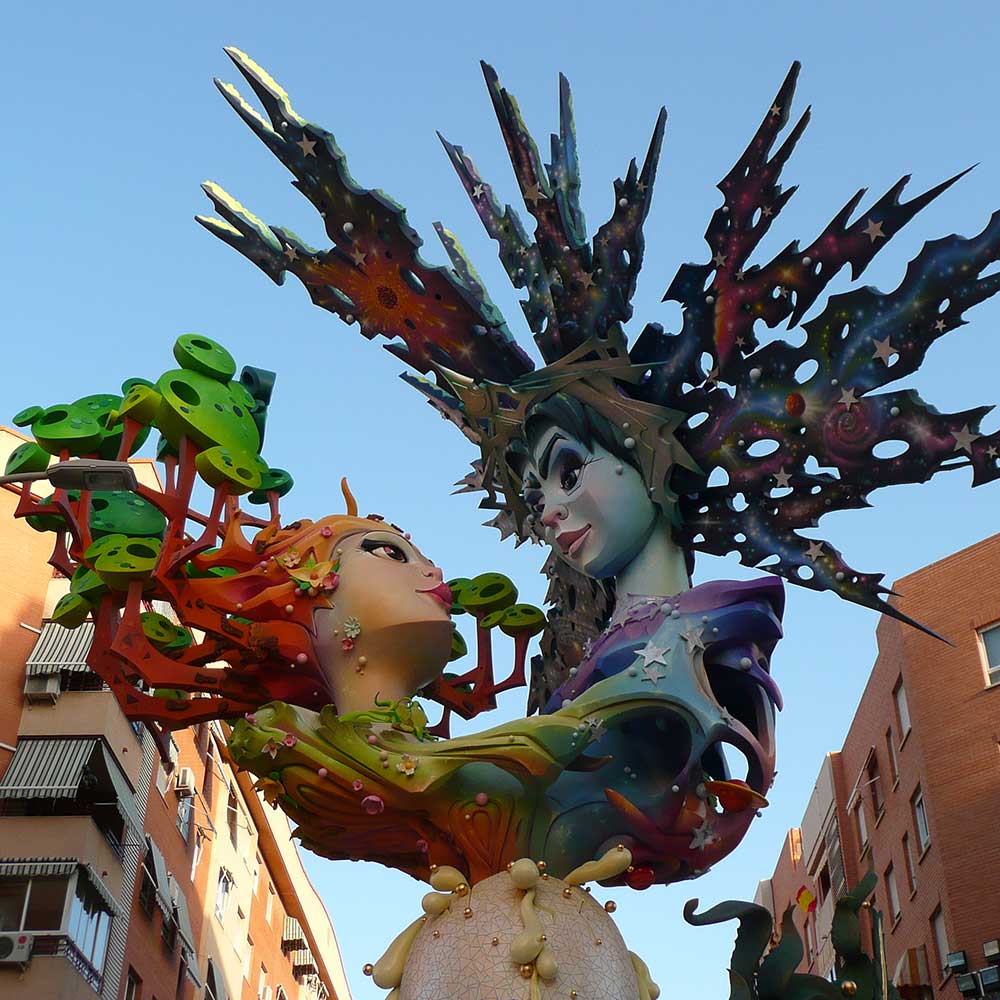Learn everything you need to know about this festival. What it consists of, what to do, where to try the typical gastronomy, tips, advice and much more!

👉 Note: In Valencian / Catalan the bonfires are called “fogueres“. It is a word that you will see written on the street many times. The word “foc” means fire.
The bonfires of San Juan are the biggest festival in Alicante. They are prepared throughout the year and are celebrated for a couple of weeks.
Whether you are a first-time visitor or a returning enthusiast, this guide will walk you through everything you need to know about the Hogueras de San Juan 2025 Festival.
The Bonfires of San Juan, or “Hogueras de San Juan,” (San Juan Festival Alicante 2025) is an annual festival held in Alicante to celebrate the arrival of summer.
The festivities revolve around the creation and burning of large, intricate sculptures made of wood and papier-mâché, known as “hogueras” or bonfires. These stunning works of art often depict satirical scenes, celebrities, political figures, and local themes, showcasing the creativity and craftsmanship of local artists.
The festival culminates in the burning of these hogueras on the night of June 24, in a spectacular event known as “La Cremà.“

April:
May:
June:
The Cremà day is the ultimate highlight of the Hogueras de San Juan. Is the same day of san juan, june 24th, the last day of this alicante fire festival.
This day is the day that all bonfires are burned. The first one is always the one at the town hall and then they are burned in order. From the lowest parts of the city to the highest.

It starts at 12:00 in the night and just at that moment a huge firework called “la palmera” is thrown from the castle. That is the signal that the first bonfire is burning.
Something very special about this day is that firefighters not only use water to extinguish the flames, but they also cool people down. So if you go to see it make sure you are in your bathing suit.
👉Note: if you are going to see the cremá and you want the firemen to get you wet, it is highly recommended that you carry a backpack and keep your phone inside the backpack in a plastic bag.
After the bonfires and until there are fireworks shows on the Postiguet beach. They start at 00:00h.
If you go to the beach be sure to go with time because it is usually crowded and it is difficult to find a good spot.

👉Note: The best horchata in Alicante is served in the Horchatería Azul, which is the oldest in Alicante. It is served with boyos called “fartons”.
A “mascletá” is a unique and essential part of the Hogueras de San Juan. During this San Juan Festival in Spain it is a daytime fireworks display that focuses more on the sound than the visual effects.

Held daily at 2 PM in the Plaza de los Luceros, the mascletá is a thunderous and rhythmic explosion of firecrackers that creates a symphony of noise and vibrations.
It’s a thrilling experience that showcases the pyrotechnic expertise of the local teams of this Alicante festival.
👉Note: The sound of the mascletá is very loud, so loud that you feel it in your whole body. It is something very exciting but perhaps not for everyone. Do not bring your dog with you, they have a hard time.
The bonfires are placed in the streets on June an event known as “La Plantà.”
This marks the beginning of the festival, and the streets of Alicante are transformed into open-air art galleries. Each neighborhood has its own hoguera, and the competition to create the most impressive and elaborate bonfire is fierce.
Artists and sculptors work tirelessly for months to prepare these creations, which are often satirical and reflect current events or social issues.

A “barrack” or “barraca” is a temporary structure set up by various neighborhoods during the Hogueras de San Juan Alicante 2025.
These barracks serve as social hubs where locals and visitors gather to eat, drink, and dance. Each barrack is decorated in a unique style, often reflecting the theme of the neighborhood’s hoguera.
They offer a variety of traditional foods and drinks, and provide a space for the community to come together and celebrate.

A “ninot” is a small, individual figure that is part of a larger hoguera. These figures are intricately crafted and often depict famous personalities, politicians, or satirical scenes.
Before the bonfires are burned, an exhibition is held where visitors can view and vote for their favorite ninot. The most popular ninot, known as the “Ninot Indultat,” is spared from the flames and preserved in the Museo de Hogueras.
This tradition adds an element of suspense and excitement, as artists and neighborhoods vie for the honor of having their ninot saved from destruction.

The Hogueras de San Juan is not just a celebration; it’s also a competition. Various contests and awards are held to recognize the best hogueras, ninots, and parades.
The most prestigious award is for the best hoguera, judged on creativity, craftsmanship, and overall impact. There are different categories based on the size and budget of the hogueras, ensuring that both large and small creations have a chance to be recognized.
Other awards are given for the best ninot, the best barrack, and the best musical performance in the parades.
The men’s attire typically includes a white shirt, black trousers, and a colorful sash, while the women’s dress is more elaborate, featuring a long skirt, apron, blouse, and a lace mantilla.
These costumes are often adorned with intricate embroidery and complement the traditional hairstyles and jewelry. These costumes are called “alicantino” and “alicantina” costumes.

The origins of the Hogueras de San Juan can be traced back to ancient pagan rituals celebrating the summer solstice.
These celebrations were later incorporated into Christian traditions, specifically honoring Saint John the Baptist, whose feast day falls on June 24. Over time, the festival evolved into the elaborate spectacle it is today, blending religious reverence with cultural expression.
The burning of the bonfires symbolizes the purification of the soul and the casting away of negativity and impurities. It’s a time of renewal and new beginnings, as the flames light up the night sky, illuminating the darkness and heralding the arrival of summer.
Originally an agricultural festival where dry harvest waste was burned, the first documented reference dates back to 1822, when lighting bonfires was prohibited. Despite the bans, the tradition persisted, becoming “festes de carrer” in 1881.
In 1928, the Alicante Atracción association, with José María Py, proposed making the bonfires official to attract tourism, similar to the Fallas of Valencia. That year, the first official bonfires were a success, attracting over one hundred thousand people. Although there were criticisms from Valencia, the celebration grew, including elements such as the Barraca and the election of the Bellesa del Foc from 1932.
Today, with nearly ninety Commissions of Foguera and over ten thousand participants, Les Fogueres de Sant Joan are the Official Festivals of Alicante, declared of National and International Tourist Interest, and in 2014, they were recognized as an Intangible Cultural Heritage by the Valencian Government.
The celebration is similar and based on the same concept. Sculptures are made, there are mascletàs, barracas, etc.
But in Alicante, they happen in the summer, while in Valencia, they occur when spring arrives. This changes everything because it allows for firefighters to spray people with water during the Cremà day in Alicante.
This is the craziest day in Alicante all year, and just for that reason alone, it’s worth experiencing.
The Bonfires of San Juan are an annual festival in Alicante celebrating the arrival of summer, involving the creation and burning of large wooden and papier-mâché sculptures . Other people call them vuurwerk alicante
The festival runs from June 19 to June 24, with the bonfires being burned on the night of June 24.
A mascletá is a daytime fireworks display focused on creating a rhythmic series of loud explosions, held daily at 2 PM during the festival.
A barrack is a temporary structure set up by neighborhoods during the festival, serving as a social hub for eating, drinking, and dancing.
A ninot is a small figure that is part of a larger bonfire sculpture, often depicting satirical scenes or famous personalities. The best ninot is saved from burning and preserved in a museum.
Main events include the Plantà (placing the bonfires), daily mascletàs, parades, the judging of bonfires, and La Cremà (burning of the bonfires) on June 24.
Wear comfortable clothing and shoes, as you will be walking a lot. Consider bringing ear protection for the loud fireworks and mascletàs.
Yes, the festival is family-friendly, but parents should be mindful of the loud fireworks and large crowds, which might be overwhelming for young children.
The Cremà is the night when the bonfires are burned, taking place on June 24. It's the culmination of the festival and is marked by spectacular flames and fireworks.
Yes and no. The celebration is similar with sculptures, mascletàs, and barracas. However, the Bonfires in Alicante are in summer, which allows for the unique tradition of firefighters spraying people with water on Cremà day.
